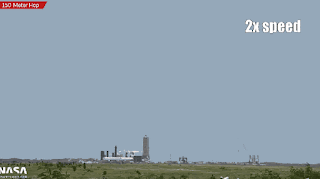An explanation of why you selected your research topic.
Though this has been an exceptionally difficult year for many they have been moments of overwhelming brilliance and inspiration. The above was one off those moments for me, the SpaceX SN5 and SN6 150m hops. These engineering feats represent the first step of the first step to to placing humans on Mars and bringing them back. A stable, reliable, and cost effective platform to move material from the Earth to orbit repeatedly is essential. But it will not be only humans traveling though our solar system, it will be the expansion of life as we know it. And in doing so life will encounter challenges it has never endured before, or that led to its extinction in other parts of the solar system.
If we take the surface of Mars for example, temperatures get to -60℃, the thin atmosphere has a pressure of only 6-7 millibars, relative humidity levels less than 1%, and no protection from ultraviolet (UV) and other cosmic radiation. These conditions will be trying for the humans, plants, fungi, bacteria, the life, that encounters them. But as alien as these conditions seem, we have a place on Earth were very similar to this, it just happens to be a few dozen kilometers above us.
The middle stratosphere provides a faithful simulacrum of the surface of Mars that would be otherwise only available at the space simulation chamber at NASA's Jet Propulsion Laboratory. The stratosphere provides a much more accessible testing environment with the use of High Altitude Balloons (HAB). Over the next academic year I will have access to HAB project through he NASA affiliated ASCEND program at Phoenix College. Due to the limitations of the project we can unfortunately not be as ambitious as the SpaceX team, but I do have freedom to design a biology project.
Specifically, the project is centered around space biology, a discipline that examines the the response of terrestrial organisms to space and space-like environments. NASA highlights three experimental frameworks in this field (Smith, 2017):
- exposure, the simplest form of performing biological science in the stratosphere – essentially, transporting known quantities of model organisms to the upper atmosphere and returning samples to the surface for subsequent laboratory analyses.
- collection, experiments that aim to acquire bioaerosols floating at altitudes far above the Earth’s surface.
- technology, includes life science instruments that could benefit from a performance evaluation in the harsh near space conditions of the stratosphere.
- What are the underlying genetic, molecular mechanisms, and biochemical processes are influenced by gravitational changes and the space environment?
- Does the space flight environment affect or influence cell and molecular functions causing tissue/organ dysfunction or disease states?
- Does the space environment affect cellular and molecular functions in a manner that impact tissue morphogenesis or development?
- What are the effects of spaceflight on microbial communities as they interact with other organisms to effect processes such as symbioses, biodegradation, nitrogen-fixation, etc.
- What are the mechanisms that effect changes, such as the altered virulence or altered drug resistance, observed in some organisms during spaceflight?
- How does gravity affect plant growth, development & metabolism (e.g. photosynthesis, re- production, lignin formation, plant defense mechanisms)?
- Does the spaceflight environment cause alterations in plant/microbe interactions?
- How can horticultural approaches for sustained production of edible crops in space be both improved and implemented (especially as related to water and nutrient provision in the root zone)?
- What are the effects of chronic exposure to cosmic radiation on plants?
David J. Smith, M. B. S. (2017). Ballooning for Biologists: Mission Essentials for Flying Life Science Experiments to Near Space on NASA Large Scientific Balloons. AIMS Geosciences, 3(2), 163–186. https://doi.org/10.1088/0067-0049/205/1/8.The



Test
ReplyDelete